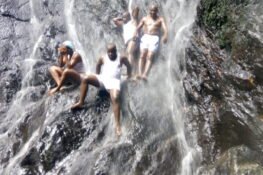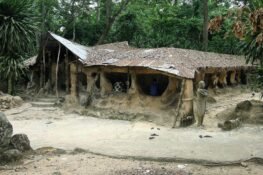The mention of Robben Island instantly creates the image of the brutal prison that held former South African President, Nelson Mandela, and other heroes of South Africa’s anti-apartheid movement, such as Govan Mbeki and Walter Sisulu.
For many tourists, a visit to Cape Town in South Africa is not complete without a trip to the Island to see Mandela’s cell, a 7-by-9-foot room where a bulb burned day and night over his head for the 18 years he was jailed there.
Today, Robben Island has become a famous tourist attraction in South Africa.
This probably informed the decision of the Government of Lagos State under the leadership of former governor Babatunde Raji Fashola to turn the Broad Street Prison, established after Britain made Lagos a Colony in 1861 to Freedom Park and a tourist spot.
Broad Street Prison was established after Britain made Lagos a Colony in 1861. The initial prison structure was built in 1882 with mud walls and grass thatch but did not last long because of sabotage from colonial government opponents.
According to Theo Lawson, architect of Freedom Park, opponents of British colonialism in Lagos “kept throwing fire into it and setting it ablaze and so in 1885 the colonial government imported bricks from England and rebuilt the prison”.
The colonial government’s expense on the prison in 1882 (£16,000) revealed the government’s priority on law and order versus other initiatives such as education which the government spent £700 on.
The Colonial report for 1898 indicates that 676 males, 26 females, and 11 juveniles were imprisoned at Broad Street prison for the year. Broad Street Prison was pulled down in 1979 and was reduced to a dump site until the 1990s when plans were drawn up to transform the site into a creative space.
The Park was constructed to preserve the history and cultural heritage of Nigerians. Monuments in the park reveal the Lagos colonial heritage and history of Her Majesty’s Broad Street prisons. It was built to commemorate the 50th anniversary independence celebration in October 2010. The Park serves as a national memorial, a historical landmark, a cultural site, arts and recreation centre.
The name, Freedom park, seems apt for a complex that once held not only criminals but freedom agitators like the late Herbert Macaulay, Nnamdi Azikiwe, Obafemi Awolowo and even Adeyemo Alakija, who were branded rebels by the colonial overlords in Nigeria at the time.
While some of the activists were held in the prison before Nigeria’s independence in 1960, Awolowo was incarcerated in the 52 cell facility again while standing trial for a treasonable felony.
The late Obafemi Awolowo remembered this prison when he wrote his book,’ My March Through Prison’.
Fashola said at the commissioning that, “taking into account our history and aspirations, this park represents to journey towards a greater goal, the triumph of humanity over all forms of tyranny, both political and social, and the ultimate liberation of the human spirit from all that seek to confine it.”
The 52 cells in the facility have been ‘intentionally preserved ‘ to remind visitors of the memory on incarceration, which ultimately resulted in freedom.
In ensuring that the facility retains the relics of the colonial masters’ style of oppression, the gallows, on which condemned prisoners were hanged, still adorn one of the apartments in the complex.
The park, which is now a serene abode for individuals, visitors’ collective contemplation and interaction, is open to the public every day as the Freedom Park has become a venue for diverse social events and entertainment.
There are always tour guides on ground to take tourists around and show the hidden treasures in the gallery and the pictures of the prison and gallows.
Within the Freedom Park, one could see and experience history, the creative imagination of some of the Nigerian leading artists and have an experience of the culture of the country.
Many works of art commissioned by the Omooba Yemi Shyllon Foundation dot the park. The works are statues painted black with fibre class as the medium. They are almost life-size statues that capture the Nigerian way of life from different ethnic groups in the country.
A Northern flutist with kaakaki – a kind of royal flute – to announce the presence of royalty; a woman displaying her kolaunts in a wooden bowl; a blacksmith working on a material; and an appreciative Urhobo groom with his in-laws. There are others in the park who take one on an imaginary trip to different parts of the country.
With its open air and indoor facilities, the Freedom Park has become a great place to hang out with friends for food and drink as well as a rendezvous for the literary inclined individuals. It is a place of art and a piece of work; a true tourist attraction in Lagos, Nigeria.
Additional reports and photos from Wikipedia and Freedom Park Website






